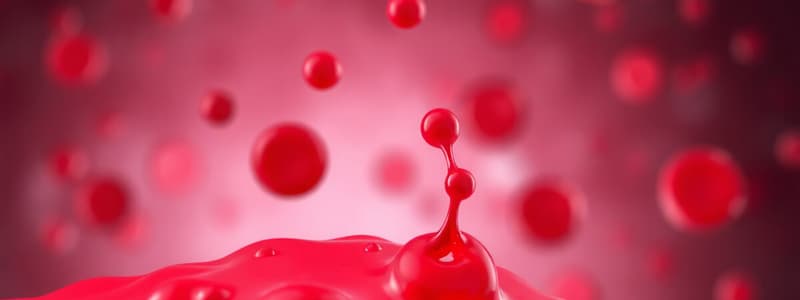Podcast
Questions and Answers
What is the primary role of coagulation in the body?
What is the primary role of coagulation in the body?
- To promote inflammation at injury sites
- To enhance blood flow to injured areas
- To convert liquid blood into gel and form clots (correct)
- To increase blood pressure during injury
Which factor is specifically known as fibrinogen?
Which factor is specifically known as fibrinogen?
- Factor X
- Factor II
- Factor I (correct)
- Factor III
What initiates the intrinsic coagulation pathway?
What initiates the intrinsic coagulation pathway?
- Release of calcium ions
- Tissue injury
- Activation of fibrinogen
- Contact with collagen fibers (correct)
What is the function of anticoagulants in the coagulation process?
What is the function of anticoagulants in the coagulation process?
Which condition is primarily associated with a deficiency in clotting factors?
Which condition is primarily associated with a deficiency in clotting factors?
Which test is used to assess the intrinsic pathway of coagulation?
Which test is used to assess the intrinsic pathway of coagulation?
Which component is critical for the conversion of prothrombin to thrombin?
Which component is critical for the conversion of prothrombin to thrombin?
What occurs during the coagulation phase of hemostasis?
What occurs during the coagulation phase of hemostasis?
Flashcards are hidden until you start studying
Study Notes
Coagulation Overview
- Definition: Coagulation is the process by which blood changes from a liquid to a gel, forming a blood clot.
- Purpose: Prevents excessive bleeding when blood vessels are injured.
Stages of Coagulation
-
Vascular Phase
- Blood vessel constriction (vasoconstriction).
- Reduction of blood flow to the injury site.
-
Platelet Phase
- Platelets adhere to the site of injury.
- Activation and aggregation of platelets, forming a temporary "platelet plug."
-
Coagulation Phase
- Activation of clotting factors leads to the conversion of fibrinogen into fibrin.
- Formation of a stable blood clot that consolidates the platelet plug.
Coagulation Factors
- Clotting Factors: Proteins synthesized by the liver, labeled with Roman numerals (I-XIII).
- Factor I: Fibrinogen
- Factor II: Prothrombin
- Factor III: Tissue factor (thromboplastin)
- Factor IV: Calcium ions (Ca²⁺)
- Factor X: Stuart-Prower factor (critical for conversion to thrombin)
Coagulation Pathways
- Intrinsic Pathway: Activated by blood contact with negatively charged surfaces; involves factors XII, XI, IX, and VIII.
- Extrinsic Pathway: Triggered by tissue injury; rapid response involving factor III and VII.
- Common Pathway: Both pathways converge, activating factor X, which leads to the production of thrombin and ultimately fibrin.
Regulation of Coagulation
- Anticoagulants: Prevent excessive clotting; examples include:
- Antithrombin III
- Protein C and Protein S
- Fibrinolysis: The process that dissolves clots naturally after the vessel is healed, involving plasminogen and its conversion to plasmin.
Clinical Importance
- Disorders:
- Hemophilia: Genetic disorders resulting in insufficient clotting factors.
- Vitamin K Deficiency: Affects synthesis of clotting factors II, VII, IX, X.
- Thrombosis: Unwanted blood clot formation.
- Tests:
- Prothrombin Time (PT): Assesses the extrinsic pathway.
- Activated Partial Thromboplastin Time (aPTT): Assesses the intrinsic pathway.
- Platelet count and function tests.
Key Takeaways
- Coagulation is essential for hemostasis.
- It involves a complex interaction of platelets, clotting factors, and blood vessel integrity.
- Disorders of coagulation can lead to serious health issues, emphasizing the importance of regulation and balance within the system.
Coagulation Overview
- Coagulation is the process where blood transforms from liquid to gel, forming a blood clot.
- It's essential to prevent excessive bleeding from injured blood vessels.
Stages of Coagulation
- Vascular Phase: Blood vessels constrict (vasoconstriction) to reduce blood flow to the injury site.
- Platelet Phase: Platelets adhere to the injured site, activating and aggregating to form a temporary platelet plug.
- Coagulation Phase: Clotting factors activate, converting fibrinogen into fibrin. This forms a stable blood clot that strengthens the platelet plug.
Coagulation Factors
- Coagulation factors are proteins synthesized by the liver and labeled with Roman numerals I-XIII.
- Fibrinogen (Factor I): Essential for forming the fibrin meshwork in blood clots
- Prothrombin (Factor II): Converted into thrombin by the coagulation cascade, a key enzyme in clot formation
- Tissue Factor (Factor III): Released from damaged tissue, initiating the extrinsic pathway of coagulation
- Calcium Ions (Factor IV): Necessary for various steps in the coagulation cascade
- Stuart-Prower Factor (Factor X): Vital for the final conversion of prothrombin to thrombin in the common pathway
Coagulation Pathways
- Intrinsic Pathway: Activated by blood contact with negatively charged surfaces, involves factors XII, XI, IX, and VIII.
- Extrinsic Pathway: Triggered by tissue injury, a rapid process involving factor III and VII.
- Common Pathway: Both intrinsic and extrinsic pathways converge, leading to the activation of factor X. This ultimately results in thrombin production and fibrin formation.
Regulation of Coagulation
- Anticoagulants: Prevent excessive clotting. Examples include Antithrombin III and the proteins C and S.
- Fibrinolysis: The process of dissolving clots naturally after the vessel is healed. It involves plasminogen and its conversion into plasmin.
Clinical Importance
- Disorders:
- Hemophilia: Genetic disorders result in insufficient clotting factors.
- Vitamin K Deficiency: Affects the synthesis of clotting factors II, VII, IX, and X.
- Thrombosis: Unwanted formation of blood clots.
- Coagulation Tests:
- Prothrombin Time (PT): Assesses the extrinsic pathway.
- Activated Partial Thromboplastin Time (aPTT): Assesses the intrinsic pathway.
- Platelet count and function tests.
Key Takeaways
- Coagulation is essential for hemostasis – the body's ability to stop bleeding.
- Coagulation involves a complex interplay of platelets, clotting factors, and blood vessel integrity.
- Coagulation disorders can lead to serious health issues highlighting the importance of regulation and balance within this complex system.
Studying That Suits You
Use AI to generate personalized quizzes and flashcards to suit your learning preferences.



